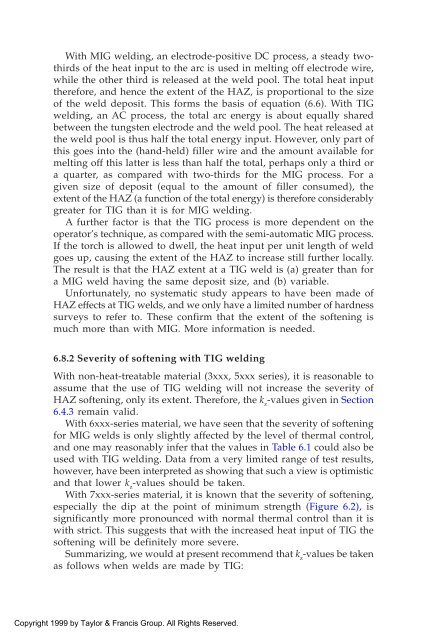Aluminium Design and Construction John Dwight
Aluminium Design and Construction John Dwight
Aluminium Design and Construction John Dwight
You also want an ePaper? Increase the reach of your titles
YUMPU automatically turns print PDFs into web optimized ePapers that Google loves.
With MIG welding, an electrode-positive DC process, a steady twothirds<br />
of the heat input to the arc is used in melting off electrode wire,<br />
while the other third is released at the weld pool. The total heat input<br />
therefore, <strong>and</strong> hence the extent of the HAZ, is proportional to the size<br />
of the weld deposit. This forms the basis of equation (6.6). With TIG<br />
welding, an AC process, the total arc energy is about equally shared<br />
between the tungsten electrode <strong>and</strong> the weld pool. The heat released at<br />
the weld pool is thus half the total energy input. However, only part of<br />
this goes into the (h<strong>and</strong>-held) filler wire <strong>and</strong> the amount available for<br />
melting off this latter is less than half the total, perhaps only a third or<br />
a quarter, as compared with two-thirds for the MIG process. For a<br />
given size of deposit (equal to the amount of filler consumed), the<br />
extent of the HAZ (a function of the total energy) is therefore considerably<br />
greater for TIG than it is for MIG welding.<br />
A further factor is that the TIG process is more dependent on the<br />
operator’s technique, as compared with the semi-automatic MIG process.<br />
If the torch is allowed to dwell, the heat input per unit length of weld<br />
goes up, causing the extent of the HAZ to increase still further locally.<br />
The result is that the HAZ extent at a TIG weld is (a) greater than for<br />
a MIG weld having the same deposit size, <strong>and</strong> (b) variable.<br />
Unfortunately, no systematic study appears to have been made of<br />
HAZ effects at TIG welds, <strong>and</strong> we only have a limited number of hardness<br />
surveys to refer to. These confirm that the extent of the softening is<br />
much more than with MIG. More information is needed.<br />
6.8.2 Severity of softening with TIG welding<br />
With non-heat-treatable material (3xxx, 5xxx series), it is reasonable to<br />
assume that the use of TIG welding will not increase the severity of<br />
HAZ softening, only its extent. Therefore, the kz-values given in Section<br />
6.4.3 remain valid.<br />
With 6xxx-series material, we have seen that the severity of softening<br />
for MIG welds is only slightly affected by the level of thermal control,<br />
<strong>and</strong> one may reasonably infer that the values in Table 6.1 could also be<br />
used with TIG welding. Data from a very limited range of test results,<br />
however, have been interpreted as showing that such a view is optimistic<br />
<strong>and</strong> that lower kz-values should be taken.<br />
With 7xxx-series material, it is known that the severity of softening,<br />
especially the dip at the point of minimum strength (Figure 6.2), is<br />
significantly more pronounced with normal thermal control than it is<br />
with strict. This suggests that with the increased heat input of TIG the<br />
softening will be definitely more severe.<br />
Summarizing, we would at present recommend that kz-values be taken<br />
as follows when welds are made by TIG:<br />
Copyright 1999 by Taylor & Francis Group. All Rights Reserved.















